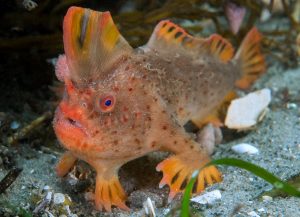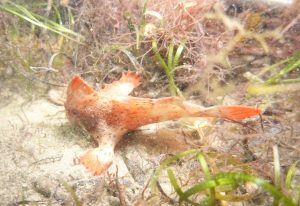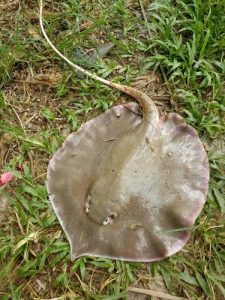Strange Animals Podcast

Episode 397: Some Colorful Fishies
Thanks to Cosmo, William, and Silas for their fishy suggestions this week!
You have until Sept. 13, 2024 to back the enamel pin Kickstarter!
Further reading:
The Handfish Conservation Project
Researchers Look in Tank and See Promising Cluster of Near-Extinct Babies
The unique visual systems of deep sea fish
A red handfish:

Another red handfish. This one is named Hector:

The black dragon fish:

The white-edged freshwater whipray [photo by Doni Susanto]:

Show transcript:
Welcome to Strange Animals Podcast. I’m your host, Kate Shaw.
This week we return to the vertebrate world, specifically some strange and colorful fishies. Thanks to William, Cosmo, and Silas for their suggestions!
We’ll start with Silas’s suggestion, the red handfish. We talked about it before back in episode 189, but it’s definitely time to revisit it. When we last discussed it, scientists estimated there were fewer than 100 red handfish left in the wild, meaning it was in imminent danger of extinction. Let’s find out how it’s doing now, four years later.
The handfish gets its name because its pectoral fins look like big flat hands. It spends most of its time on the sea floor, and it uses its hands to walk instead of swimming. It can swim, although it’s not a very strong swimmer, and anyway if you had great big hands you might choose to walk on them too. It doesn’t have a swim bladder, which helps most fish stay buoyant.
All species of handfish are small, only growing to about 6 inches long at most, or 15 cm. This is surprising considering the handfish is closely related to anglerfish, and some anglerfish can grow over 3 feet long, or about a meter.
As for the red handfish specifically, it generally only grows about 4 inches long at most, or 10 cm, and it once lived in shallow water around much of Australia. These days, it’s only found on two reefs southeast of Tasmania. Some populations are bright red while some are pink with red spots. It has a wide downturned mouth that makes it look like a grumpy red toad with big hands.
So how is the red handfish doing? Four years ago it was almost extinct in wild, with fewer than 100 individuals alive. These days the Handfish Conservation Project estimates that the wild population is probably about the same, although because the red handfish is so small and hides so well among sea grass, algae, and rocks that make up its home, it’s hard to get a good count of how many are really alive. It’s also under even more pressure than before as an overpopulation of urchins is overgrazing the plants where it lives, which may sound familiar to you if you listened to episode 395 a few weeks ago. But there is one fantastic change that gives conservationists hope that the red handfish won’t go extinct after all.
The red handfish is so endangered, and its remaining habitat is so small, that a few years ago scientists decided they needed to start a captive breeding program. But even though the fish did just fine in captivity, they didn’t breed at first. Then, in November 2023, one of the fish laid 21 eggs and all 21 hatched safely. Hopefully it won’t be long until the babies are old enough to release into the wild.
The red handfish is one of very few fish that hatch into tiny baby fish instead of into a larval form. Newly hatched babies are only about 5 mm long. Most fish colonize new habitats after they float around aimlessly as larvae, until they grow enough to metamorphose into adults. Since the red handfish doesn’t have this larval stage, and babies just walk around on the sea floor finding tiny worms and other food, it’s hard for the fish to expand its range. Hopefully, as the captive breeding program continues and more young fish are released into the wild, scientists can start releasing red handfish into areas where they used to live.
Next, William asked about the dragon fish. We’ve talked about a few dragonfish before, in episodes 193 and 231, but there are lots of species in many genera in the family Stomiidae. Many have barbels with photophores at the end that lure prey, and most have long needle-like teeth and jaws that can open incredibly wide. They also have stretchy stomachs so they can hold whatever they manage to catch. As you may have guessed from these traits, the dragon fish lives in the deep sea where there’s little or no light from the surface.
You may wonder why deep-sea fish even have eyes if there’s no light. Fish that live in cave systems eventually evolve to be eyeless, since they don’t need their eyes to see and growing eyes is just a waste of their energy. It’s because even though there’s no sunlight in the deep sea, there is light from lots of different organisms. Many, many deep-sea animals produce bioluminescent light to attract mates or trick smaller animals into coming closer.
Any sunlight that does find its way to the depths of the ocean is blue, because blue has the shortest wavelength and can travel farther. Red wavelengths are longest so that red is the first color lost when you start descending into the water. One article that I’ve linked to in the show notes mentions that if a diver gets a cut, the blood looks brown or even black if the water is deep enough. That’s creepy.
As a result, deep-sea fish are most sensitive to the color blue. Most of them can’t perceive red at all because there just isn’t any red in their environment. And that’s where the dragon fish comes in, because some species of dragon fish can not only see red, they produce red light that illuminates everything around them. A fish or other animal swimming along has no idea that it’s lit up like it’s under a red spotlight because it can’t even see that color.
At least one species, the black dragon fish, perceives red light very differently from the way other animals do. As far as we know it’s unique among all animals. Its eyes contain a photosensitizer derived from chlorophyll, which allows it to see shorter lightwaves. Chlorophyll is found in plants and some bacteria, and it’s actually a specialized pigment that absorbs energy from light. It’s the reason why plants are green. But the black dragonfish uses the chlorophyll it digests to perceive red light.
But remember how dragon fish have giant sharp fangs and will eat pretty much anything they can swallow? Where does the black dragon fish get the chlorophyll it needs? There aren’t any plants in the deep sea anyway.
The answer seems to be that the black dragon fish eats a whole lot of copepods, tiny crustaceans that live throughout the world. The particular species of copepods that the black dragon fish prefers contain a type of chlorophyll.
Finally, Cosmo wanted to learn about the freshwater stingray. We talked about it in episode 296, but mostly we concentrated on the South American fish in that episode. There are freshwater stingrays that live in other parts of the world, such as Asia. This includes the white-edge freshwater whipray, which is extremely rare and only found in four rivers in Southeast Asia.
The white-edge freshwater whipray grows up to two feet across, or 60 cm, with a thin tail about two and a half times longer than the body itself so that technically it can grow around 6 and a half feet long, or 2 meters. Most of that length is tail, though. It’s mostly brown so it can hide in the sandy mud at the bottom of the river, with black dermal denticles down the middle of its back. The tail is mostly white, though, and has two long stinging spines that can be over 3 inches long, or 8 cm.
While the white-edged whipray lives in rivers, it can also tolerate brackish water where the ocean and the river waters mix. It eats small animals it finds on the bottom of the river, including crustaceans and mollusks. It’s endangered due to habitat loss, overfishing, and pollution.
The white-edged whipray is so rare these days that it’s unlikely that anyone would accidentally step on one in the water. But if they did, the ray would whip its long tail up and jab the spines into the person’s leg or foot. The spines can do a lot of damage on their own, but the venom they inject makes the wound incredibly painful and can even potentially kill the person.
If you plan to do some wading in a South Asian river anytime soon, make sure to shuffle your feet as you walk to scare away any potential whiprays before you step right on it.
You can find Strange Animals Podcast at strangeanimalspodcast.blubrry.net. That’s blueberry without any E’s. If you have questions, comments, or suggestions for future episodes, email us at strangeanimalspodcast@gmail.com. We also have a Patreon at patreon.com/strangeanimalspodcast if you’d like to support us for as little as one dollar a month and get monthly bonus episodes.
Thanks for listening!






 Visit Podcast Website
Visit Podcast Website RSS Podcast Feed
RSS Podcast Feed Subscribe
Subscribe
 Add to MyCast
Add to MyCast